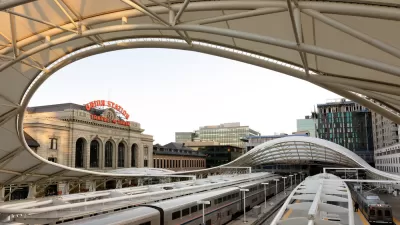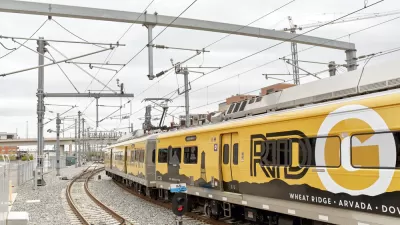FasTracks, one of the most ambitious long-term transit plans in the U.S., has been underway for over 15 years. With the finish line in sight, some locals wonder how useful the new hub-and-spoke system (regional routes connecting to downtown) will be.

Nathaniel Minor checks in with the ongoing project to build more than 100 miles of passenger rail connecting Denver's suburbs to the city's downtown. The FasTracks plan, adopted by the Regional Transportation District in 2004, is now three-quarters of the way to complete, and some locals have been left to wonder about the efficiency of the hub-and-spoke network.
Minor starts this examination with the testimony of Sam Chesser, who, as a teenager in Aurora in the early 2000s, thought the system would transform Denver. "Chesser is now in his 30s, with a wife, a dog and a mid-century bungalow in Chaffee Park," according to Minor, "[a]nd, he’s sad to say, he almost never uses the trains."
The cause of Chesser's indifference is a public transit paradigm repeated in cities and regions all over the United States. Minor summarizes:
He cites a host of reasons — they’re expensive, they’re typically slower than driving. But one stands above the rest: They don’t go where he needs to go. Even though FasTracks was primarily designed to carry commuters from the suburbs to downtown and more than two dozen stations are in Denver proper, they’re often in hard-to-reach places. The nearest station to Chesser’s house, for example, is more than two miles away, tucked into the armpit of interstates 76 and 25.
According to Chesser, the city of Denver once had the public transit system more resembling his hopes for FasTracks: the historic network of streetcars known as the Denver Tramway. According to Minor, while that system was long ago dismantled, the city also missed a chance in the late '80s and early '90s to build a light rail line between Downtown Denver and the old Stapleton Airport, "running through the heart of Denver’s historic Black neighborhoods of Five Points and Park Hill via Martin Luther King, Jr. Boulevard." That plan failed due to local opposition that viewed the proposed rail line as a desecration of the legacy of Martin Luther King, Jr. To Bishop Acen Phillips, a minister in Denver for 50 years, "cars meant freedom from the racist streetcars he had to use in Kansas City, where he went to junior college," explains Minor.
Hub-and-spoke transportation planning, with downtown as the hub and suburban stations located along the spokes, was a controversial paradigm of transportation planning before FasTracks and has only become more debatable since the pandemic upended daily routines and with so many downtown workers now working from home. Commuter rail systems have seen some of the steepest declines in ridership during the pandemic and are facing some of the biggest obstacles to returning to a pre-pandemic normalcy.
More on the long, see-sawing history of transit planning in the Denver region can be found in the source article below.
FULL STORY: Why don’t RTD’s trains go into Denver’s neighborhoods?

Alabama: Trump Terminates Settlements for Black Communities Harmed By Raw Sewage
Trump deemed the landmark civil rights agreement “illegal DEI and environmental justice policy.”

Planetizen Federal Action Tracker
A weekly monitor of how Trump’s orders and actions are impacting planners and planning in America.

Why Should We Subsidize Public Transportation?
Many public transit agencies face financial stress due to rising costs, declining fare revenue, and declining subsidies. Transit advocates must provide a strong business case for increasing public transit funding.

Understanding Road Diets
An explainer from Momentum highlights the advantages of reducing vehicle lanes in favor of more bike, transit, and pedestrian infrastructure.

New California Law Regulates Warehouse Pollution
A new law tightens building and emissions regulations for large distribution warehouses to mitigate air pollution and traffic in surrounding communities.

Phoenix Announces Opening Date for Light Rail Extension
The South Central extension will connect South Phoenix to downtown and other major hubs starting on June 7.
Urban Design for Planners 1: Software Tools
This six-course series explores essential urban design concepts using open source software and equips planners with the tools they need to participate fully in the urban design process.
Planning for Universal Design
Learn the tools for implementing Universal Design in planning regulations.
Caltrans
Smith Gee Studio
Institute for Housing and Urban Development Studies (IHS)
City of Grandview
Harvard GSD Executive Education
Toledo-Lucas County Plan Commissions
Salt Lake City
NYU Wagner Graduate School of Public Service





























